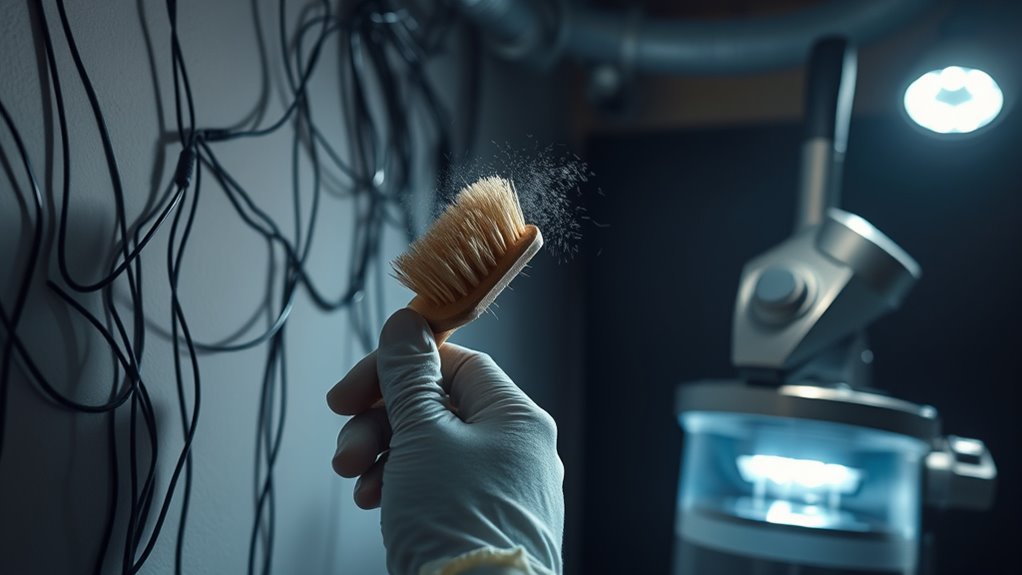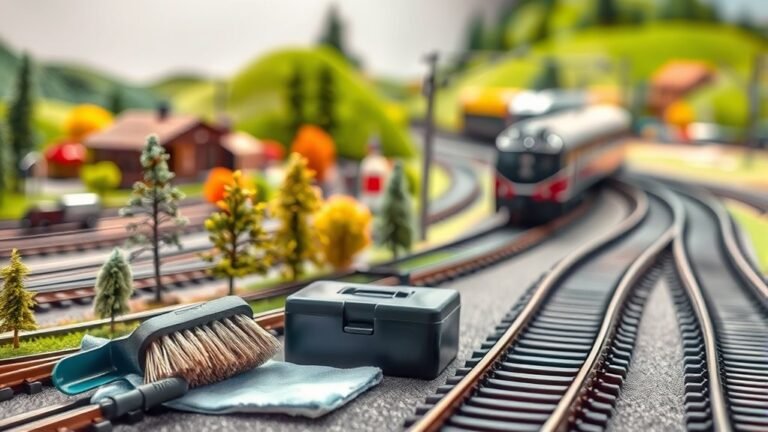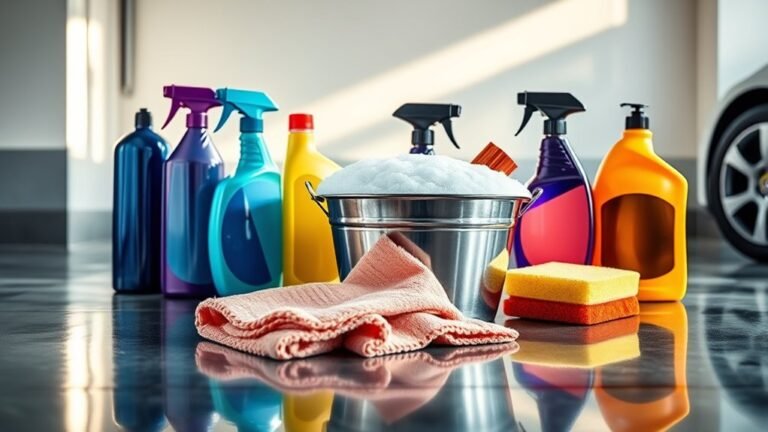Tips for Cleaning Around Exposed Wiring Safely
Before cleaning around exposed wiring, always turn off the power at the circuit breaker to avoid shocks. Use insulated brushes and cloths, and wear protective gloves and goggles for safety. Avoid water or liquid cleaners—opt for dry dusters or specialized electrical cleaners instead. Clear flammable materials from the area and clean gently to avoid damaging wires. After cleaning, inspect the wiring carefully. If needed, call a licensed electrician for repairs. You’ll find more tips to keep your space safe and well-maintained ahead.
Assess the Wiring Condition Before Cleaning
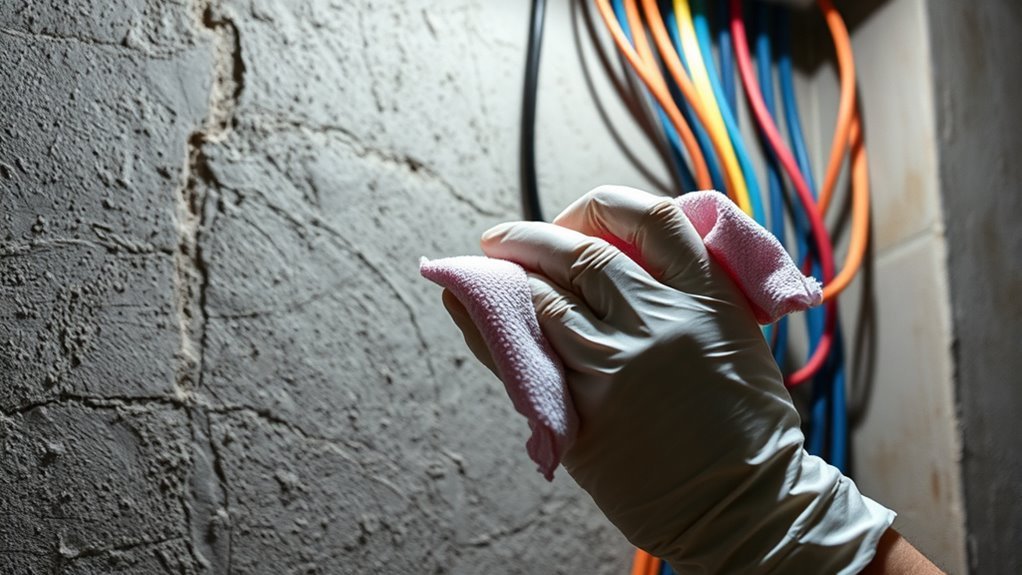
Before you begin cleaning around exposed wiring, you’ll need to carefully assess its condition to secure your safety. Conducting a thorough wiring inspection helps you spot frayed wires, loose connections, or any signs of damage that could pose risks. Don’t rush this step—it’s essential to understand the wiring’s state before proceeding. Safety precautions are your best friends here; make sure you’re not touching wires that look compromised or damp. Use a flashlight to get a clear view and avoid disturbing the wiring unnecessarily. Taking the time to evaluate the wiring condition empowers you to clean confidently without risking electric shock or short circuits. Remember, your freedom to maintain your space safely starts with this critical wiring inspection.
Turn Off Power Supply to the Area
Before you start cleaning, make sure to locate the circuit breaker that controls the area with exposed wiring. Turn it off to cut the power supply and reduce the risk of electric shock. Double-check that the power is actually off by testing the outlets or switches nearby.
Locate Circuit Breaker
To guarantee your safety while cleaning around exposed wiring, the first step is to locate the circuit breaker that controls power to the area. This means you need to identify the right breaker by checking the circuit identification in your breaker panel. Many panels have breaker labeling, which can make this easier—look for labels that correspond to the room or area you’re working in. If the labeling isn’t clear or missing, take the time to trace wires or use a circuit tester to pinpoint the correct breaker. Taking control of this step gives you the freedom to work safely without risking an accidental shock or electrical hazard. Knowing exactly which breaker to switch off is your key to a secure and hassle-free cleaning experience.
Verify Power Is off
Once you’ve identified the correct circuit breaker, make sure to switch it off to cut power to the area completely. This step is essential for wiring safety and protects you from electrical hazards while cleaning. Don’t assume the power is off just because the breaker is switched; use a non-contact voltage tester to double-check. This device quickly confirms there’s no live current, giving you peace of mind and the freedom to clean safely without fear. Remember, even a small electrical shock can cause serious injury or disrupt your day. Taking this simple precaution lets you focus on your cleaning tasks confidently, knowing you’ve minimized risks. Prioritizing wiring safety means you can enjoy a clean space without compromising your well-being.
Use Insulated Cleaning Tools
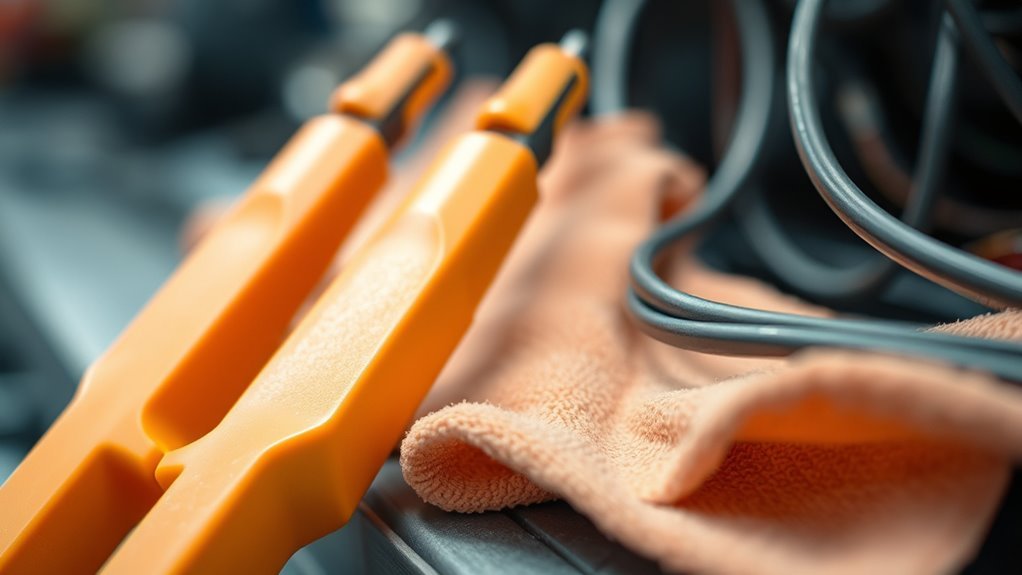
One essential step when cleaning around exposed wiring is using insulated cleaning tools. These tools, like insulated brushes and safety gloves, protect you from accidental electric shocks, letting you work confidently and freely. Insulated brushes help remove dirt without conducting electricity, while safety gloves shield your hands from direct contact with wires. Choosing the right tools guarantees your safety and makes cleaning more efficient.
| Tool Type | Purpose |
|---|---|
| Insulated Brushes | Remove dust without conductivity |
| Safety Gloves | Protect hands from electric shock |
| Insulated Cloths | Wipe surfaces safely |
| Non-conductive Picks | Clear tight spots without risk |
| Insulated Screwdrivers | Adjust fittings safely |
Using these tools lets you maintain freedom to clean safely around exposed wiring.
Avoid Using Water or Liquid Cleaners Near Wiring
Although cleaning liquids can be effective for many surfaces, you shouldn’t use water or liquid cleaners near exposed wiring. Liquids can cause short circuits, damage components, or even lead to electric shock. To maintain freedom in your cleaning routine while ensuring safe cleaning, opt for liquid alternatives designed for electrical areas.
Consider these tips to keep your space safe and clean:
- Use dry cloths or microfiber dusters to remove dust without moisture.
- Choose specialized electrical contact cleaners that evaporate quickly and leave no residue.
- Apply cleaning powders or compressed air to clear debris without risking liquid exposure.
Wear Protective Gear for Safety
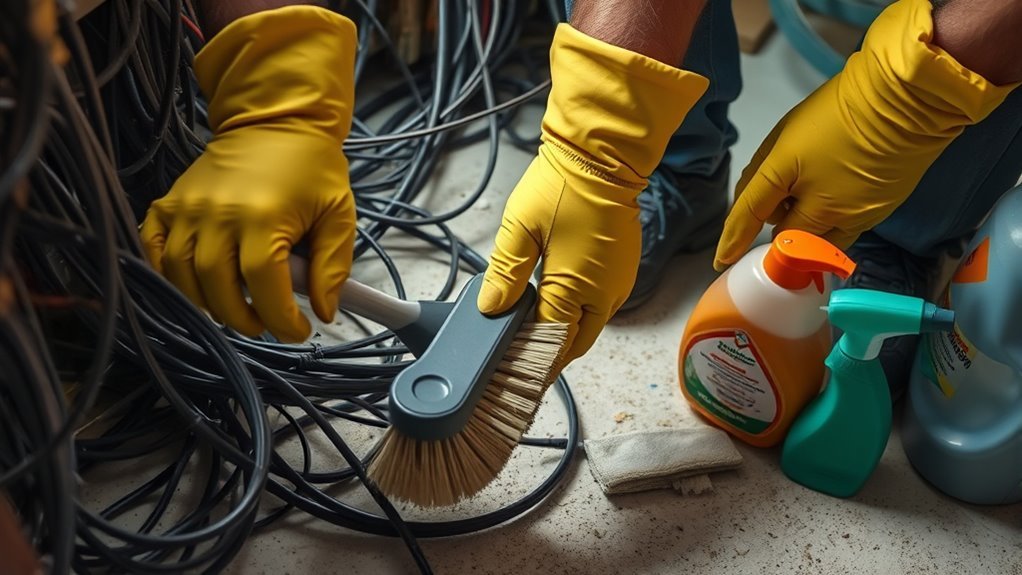
When cleaning near exposed wiring, you need to wear essential protective gear like insulated gloves and safety goggles. Make sure your equipment fits properly to provide the best protection. Wearing the right gear can prevent electrical shocks and injuries.
Essential Protective Equipment
Protective gear is your first line of defense when cleaning around exposed wiring. You want to stay safe while maintaining your freedom to handle tasks confidently. Don’t skip on the essentials—they shield you from unexpected shocks and debris.
Make sure you have:
- Protective gloves: They prevent electrical shocks and keep your hands clean.
- Safety goggles: These guard your eyes from dust, sparks, or any flying particles.
- Non-conductive footwear: Wearing shoes with rubber soles reduces the risk of electrical accidents.
Proper Use and Fit
Since gear only works if it fits right, you’ll want to make certain your gloves, goggles, and shoes are snug but comfortable. A proper fit isn’t about restriction; it’s about freedom—allowing you to move confidently without worrying about slipping or distractions. When selecting your protective gear, prioritize tool selection that complements your size and task. Ill-fitting gloves can reduce dexterity, while loose goggles may fog or fall off, compromising safety. Shoes should provide solid grip and full coverage without pinching. Remember, the right fit enhances your control and responsiveness when working near exposed wiring. Don’t just grab any gear—choose pieces designed for your needs and verify they’re adjusted correctly before you start cleaning. This way, you stay safe and free to work efficiently.
Clear the Area of Flammable Materials
Before you start cleaning around exposed wiring, make sure to remove any flammable materials nearby. This step is essential to keep your space safe and maintain your freedom from fire hazards. Flammable items can ignite quickly if a spark occurs, so clearing them out is a smart fire safety measure. Store any necessary flammable products in flame resistant storage containers and keep them away from the wiring area.
Here’s what to clear away before you begin:
- Paper, cardboard, and other easily combustible materials
- Aerosol cans and solvents that can catch fire
- Fabrics like curtains or rugs close to wiring
Taking these precautions helps you clean confidently without risking fire or damage.
Clean Gently to Prevent Damage to Wires
Although cleaning around exposed wiring is important, you’ll want to be very gentle to avoid causing damage. Using gentle techniques guarantees that the wires stay intact and functional, preserving your freedom to use electrical devices safely. Avoid harsh scrubbing or abrasive tools that might strip insulation or loosen connections. Instead, opt for soft brushes or microfiber cloths to carefully remove dust and debris. When wiping, use minimal moisture to prevent short circuits or corrosion. Regular wire maintenance with gentle cleaning not only extends the lifespan of your wiring but also reduces the risk of electrical hazards. By treating your wiring with care, you maintain both safety and the freedom to manage your space without worry.
Inspect Wiring After Cleaning
After gently cleaning your exposed wiring, you’ll want to take a close look to confirm everything is still in good shape. A thorough wiring inspection guarantees safety and helps you maintain control over your space. Use these maintenance tips to keep your wiring reliable and secure:
- Check for any cracks or nicks in the insulation that could expose wires.
- Ascertain all connections are tight and haven’t loosened during cleaning.
- Look for any discoloration or signs of overheating near the wiring.
Call a Professional for Repairs or Upgrades
If you notice any damage or feel unsure about the condition of your wiring, it’s best to call a professional for repairs or upgrades. Handling wiring upgrades and electrical repairs on your own can be risky and might limit your freedom if something goes wrong. A licensed electrician has the skills and tools to guarantee your wiring is safe, code-compliant, and efficient. Plus, they can spot hidden issues you might miss, preventing future problems. Taking this step not only protects your home but also gives you peace of mind, allowing you to enjoy your space without worry. When it comes to exposed wiring, trusting experts for repairs or upgrades guarantees safety and preserves your independence over your living environment.
Frequently Asked Questions
Can Exposed Wiring Cause Health Issues Besides Electrical Hazards?
Yes, exposed wiring can cause health issues beyond electrical hazards. You might not realize it, but wiring contamination can lead to problems like respiratory issues if dust or mold collects around the wires. These health risks could affect your well-being, especially if you’re sensitive to allergens or toxins. So, it’s important to keep an eye on exposed wiring to protect your freedom to live safely and breathe easy in your space.
How Often Should Exposed Wiring Areas Be Cleaned?
Imagine dust and grime quietly settling around your exposed wiring, like unwanted guests crashing your freedom-filled space. You’ll want to establish a regular cleaning frequency—ideally once a month—to keep things safe and spark-free. Stick to a maintenance schedule that fits your lifestyle, ensuring your wiring stays clear without restricting your independence. Regular care means fewer risks and more freedom to enjoy your space worry-free.
What Are Common Signs of Deteriorating Insulation on Wiring?
You’ll want to watch for brittleness, cracks, or peeling on the wiring’s outer layer—that’s a clear sign of deteriorating insulation. Discoloration or melting spots can also indicate problems. These issues compromise wiring safety, increasing the risk of electrical shorts or fires. If you spot any of these signs, it’s essential to address them promptly so you can maintain your freedom to use your space safely and confidently.
Are Certain Types of Wiring More Dangerous When Exposed?
Just like the ticking bomb in a thriller, exposed high voltage wiring is far more dangerous than low voltage. If you value your freedom and safety, you’ll want to steer clear of high voltage wires—they can cause severe shocks or fires. Low voltage wiring, while still risky, is less likely to deliver a deadly jolt. Always treat any exposed wiring with caution to keep your independence intact and avoid harm.
Can Cleaning Exposed Wiring Improve Electrical Efficiency?
While cleaning exposed wiring won’t directly boost electrical efficiency, regular wire maintenance can prevent dirt or corrosion from causing resistance or short circuits. Keeping wires clean helps guarantee connections stay solid, which supports better performance over time. So, if you want to enjoy your electrical freedom without unexpected issues, it’s wise to maintain your wiring properly. Just be sure to follow safety precautions while doing so to avoid any hazards.
